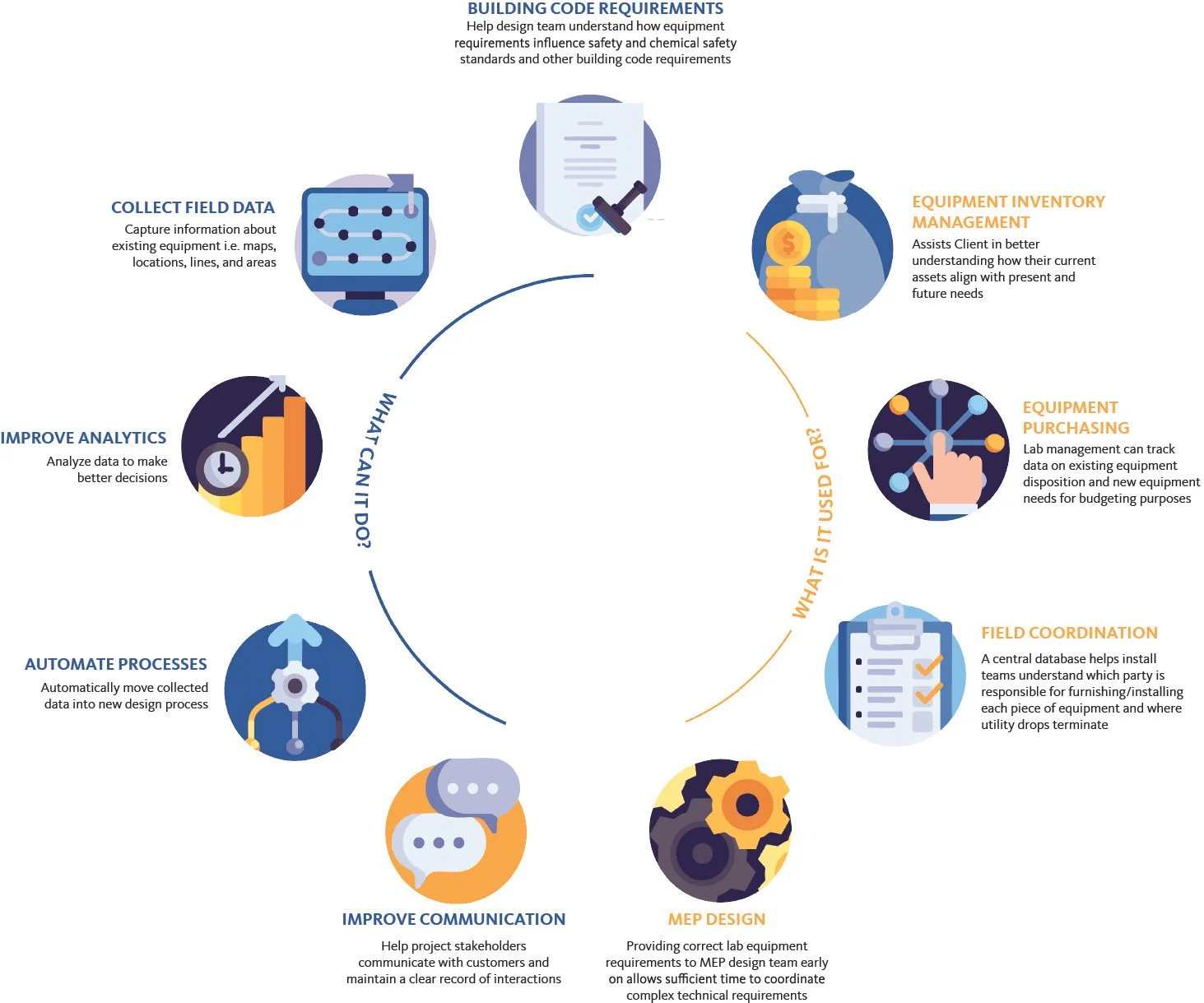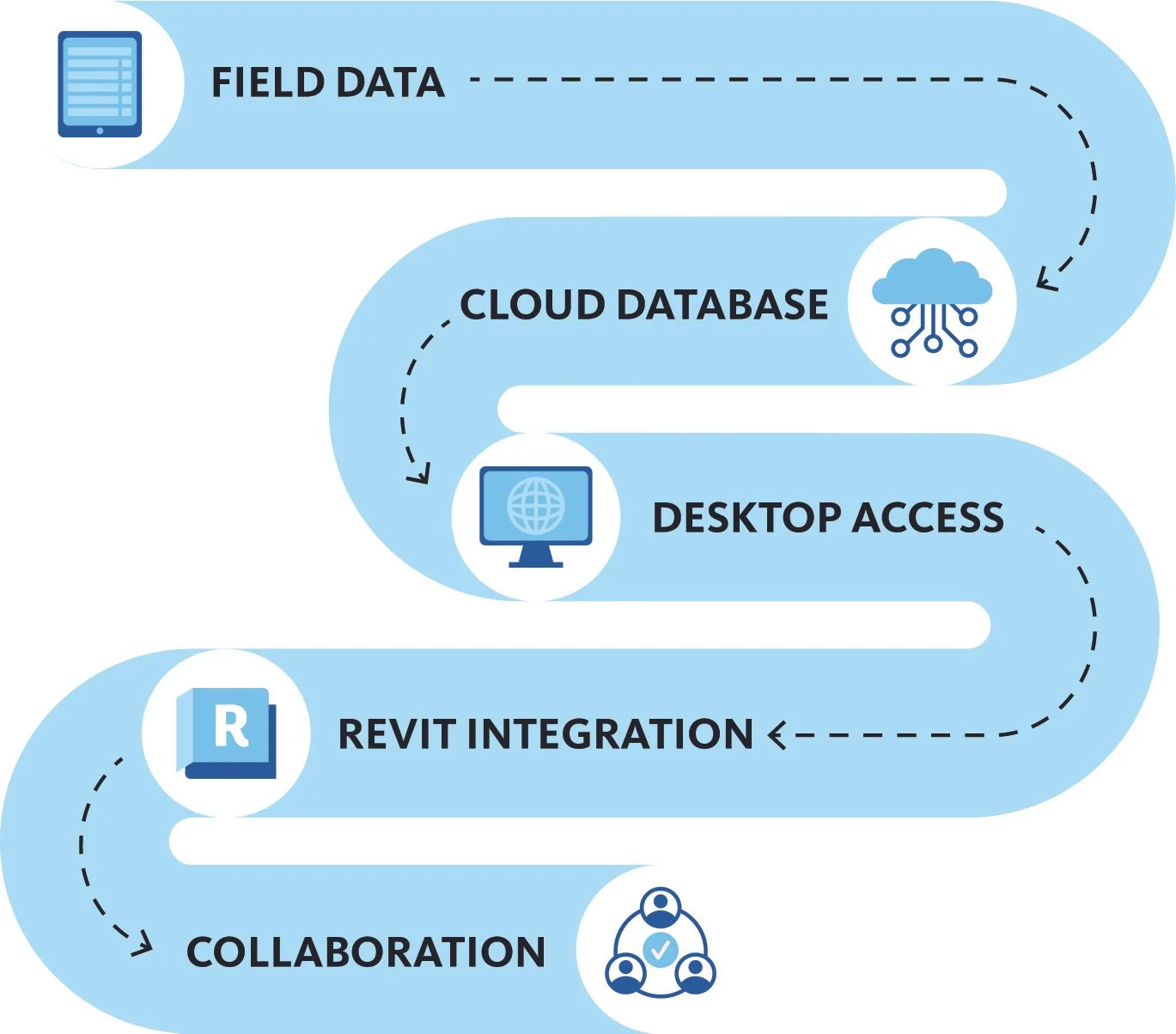Utilizing Cloud-Based Data Management to Streamline Laboratory Relocations
Manual equipment surveys in laboratory relocations are time-consuming, error-prone, and often lead to costly design delays due to data silos and outdated collection methods. Image: Courtesy of Gensler
Debora Walker, designer-associate at Gensler, is co-author of this piece.
Equipment in labs is expensive, highly specialized, and often outlives the space it is used in. As a result, research organizations struggle with the equipment planning aspect of laboratory relocations due to staffing and time constraints. However, getting the equipment right is essential for the lab to function as designed. Inaccurate or incomplete data resulting from data silos, information gaps and manual data entry can cause costly design or project delays.
Equipment surveys have traditionally been provided by an owner in an Excel file, or it was collected manually on-site using paper and pen. This is a time-consuming and labor-intensive process which often results in confusion about the identification of items and the accuracy of information. The process is also limited by a single individual’s ability to access the data.
By leveraging a customized mobile data collection process, facilities such as BioLabs New Haven ensure accurate equipment tracking, minimizes design delays, and enables seamless integration with 3D design models—establishing a single source of truth throughout the project lifecycle. Image: Connie Zhou, courtesy of Gensler
With the knowledge and expertise Gensler’s lab designers acquired in their work, the team recently helped customize and implement a proprietary cloud-based data management and mobile data collection process that can be utilized to ensure accurate and up-to-date information across all project phases. This allows for multiple users to access the software at the same time, offering a team-based approach and increasing collaboration. Additionally, this method can determine the linear and square footage needed to relocate a group or subgroup. Cloud-based data management and collection establish a single source of truth throughout a project’s entire lifecycle.
The process, outlined below, includes transferring field data about existing equipment to a cloud database through a mobile app, creating desktop access to the centralized data for reference and editing, and integrating with a 3D design model to perform batch data updates.
Cloud-based data management: what can it do and what is it used for?
A centralized equipment database streamlines lab planning by supporting field data collection, MEP coordination, code compliance, purchasing, and communication—ultimately driving smarter, faster decision-making. Image: Courtesy of Gensler
Collecting field data: Capturing information about existing equipment (i.e. dimensions, locations, specifications, and utility requirements).
Understanding building code requirements: Allowing the design team to better understand how equipment requirements influence safety standards and other building code requirements.
Managing equipment inventory: Assisting companies in understanding how their current assets align with present and future needs.
Purchasing equipment: Aiding lab management in tracking data on existing equipment disposition and new equipment needs for budgeting purposes.
Facilitating field coordination: Establishing a central database helps install teams understand which party is responsible for furnishing/installing each piece of equipment and where utility drops terminate.
Streamlining MEP design: Providing correct lab equipment requirements to the MEP design team early on allows for sufficient time to coordinate complex technical requirements.
Improving communication: Helping project stakeholders communicate with customers and maintain a clear record of interactions.
Automating processes: Moving collected data into the new design process automatically.
Enhancing analytics: Analyzing data to make better decisions.
Planning for a seamless transition
BioLabs New Haven is an example of how cloud-based data management can streamline complex lab relocations by replacing outdated, error-prone equipment surveys with a collaborative, real-time system. Image: Connie Zhou, courtesy of Gensler
With information now accessible to all parties in real-time, a lab relocation should be less time intensive. In our work, we’ve implemented this method successfully when relocating a company’s four existing North American facilities to one city-based campus comprised of multiple buildings. Typically, the process of surveying and documenting existing assets from multiple facilities would have taken approximately six months, but with the availability of the cloud-based data management platform, we were able to complete the project in a third of the time.
Maintaining established processes
A cloud-based data management approach improves lab planning efficiency, reduces facility costs, and provides actionable insights for future relocations and asset optimization. Image: Courtesy of Gensler
After adopting this cloud-based data management approach, not only should the laboratory planning and design process be more efficient, but a company should also see reduced facility costs. As equipment is acquired or removed, the cloud service offers a clear evaluation of the assets driving the organization’s bottom line. For example, a client can categorize types of equipment that utilize similar processes to minimize redundancies, which results in the ability to liquidate assets and eliminate costs associated with maintenance, operations and relocation. The process also offers lab planners a data point for the future organization of equipment if another relocation occurs, or if an additional use is identified.
Future applications
As our world continues to become more data-driven, we envision the cloud-based data management system becoming more ubiquitous in the lab relocation process. With continued refinement, there are also possibilities for the platform to integrate with other business operations, such as finance, supply chain management, and logistics. Overall, embracing the technology allows users to increase knowledge, accessibility, communication, and collaboration, which creates a more streamlined relocation project.
Debora Walker, co-author of this piece, is a designer, project manager, associate with Gensler in Houston, TX.






